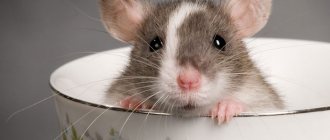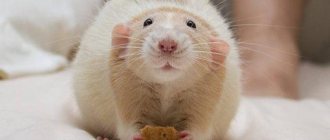Rats are intelligent, affectionate and playful companion animals. And if you've never owned a rat before, you might be wondering what their lifespan is.
Choosing a healthy pet rat and providing it with proper care and nutrition throughout its life can go a long way in extending its life.
What determines the lifespan of a rodent?
- Pedigree of the rat.
An inexperienced breeder may cross-breed sick animals and pass on undesirable traits to the baby rat, such as an inherited health condition, along with a certain color or coat pattern.
The optimal age for purchasing pet rats is about 6 weeks. Look for a healthy rat with shiny fur and lively eyes. Healthy rodents should also be active and inquisitive.
The rat you choose should not be sneezing, have a runny nose or red eyes. And you should make sure that the rat's droppings are dark and hard.
- Rat nutrition throughout life.
A rich diet for your pet rat is a guarantee of a long and happy life. Make sure she eats food specifically made for rats, and be aware of which human foods are safe to eat as rodent treats and which are toxic.
Genetics
In addition to living conditions, heredity has a great influence on the lifespan of rats. It is better to take a baby rat from breeders who not only receive offspring from healthy parents, but also provide competent care for newborn animals. Matings of decorative rats in nurseries always take place according to plan, and not randomly. To obtain offspring, healthy adults are selected that do not show aggressiveness or other undesirable character traits. Females in nurseries typically have no more than two litters in their lifetime. Too frequent pregnancies are undesirable because they exhaust the rat. In addition, as a result of multiple or too early pregnancies, small rat pups with poor health are born.
Tame rats sold in pet stores are often born from unplanned matings. Usually no one monitors the health of parents. Rats of both sexes live together in cramped cages, which is unacceptable. Under normal conditions, a male and female rat are placed in the same cage only for planned mating. The rest of the time, domestic rats should live in same-sex packs. In most pet stores, these conditions are not met; rats mate uncontrollably and too often, which, naturally, does not have the best effect on the health and vitality of the offspring.
How to extend the life of a pet?
Once you bring your new rat home, how do you ensure it has a long, healthy life? This can be done with the right diet. Here are some tips from nutrition experts:
- Plan your rat's diet. Like other pets, rats that are fed large portions of junk food can become obese. Even a small reduction in food intake can significantly increase the number of years your pet will live and improve its overall health.
- Feed your rodent food rich in antioxidants. As in humans, oxidative stress caused by free radicals in the body can cause disease and accelerate the aging process.
- Provide your rat with fresh vegetables such as carrots, broccoli and peas. Be sure to feed your pet food designed for rats and not other small rodents, as each animal has different nutritional needs.
- You can feed your rats fresh fruit from time to time. Rats also enjoy foods such as bread, nuts and boiled eggs.
However, save these foods for special occasions, as too many treats contribute to unhealthy weight gain. Additionally, a diet high in sugar and fat is unhealthy for a rat and can lead to health problems, just like in humans.
Care
Lifespan depends on care. It is important to consider many points and familiarize yourself with them before purchasing a pet:
- The pet's cage should be spacious and mesh. It should provide a place to sleep. Usually - a special house made of wood or other non-toxic material. Rodents are active animals. It is advisable that special obstacles are located in the home. You can make them yourself or purchase them at any nearby pet store. It’s better to take two rodents at once. One needs to devote more time so that he does not get bored. The home must have filler.
- The rodent's place of residence must always be kept clean. The drinking bowl should be washed daily and any leftover food should be thrown away. The cage should be thoroughly cleaned at least once a week. From time to time, your pet should be allowed to walk around the room. At the same time, it is important to ensure that no one steps on him and that there are no other animals nearby that could harm him.
- The rodent should be fed with special food. Such food is balanced and contains the necessary amount of vitamins and microelements. Proper nutrition is the key to longevity. 20% of the diet should be fresh vegetables. From time to time you can pamper your rat with boiled lean meat. It is also recommended to feed sprouted grains.
Periodically, you need to take your rodent to a veterinary clinic for examination. This will allow timely detection and prevention of some pathologies. It is strictly forbidden to place wood filler in the cage. It negatively affects the pet's respiratory system. This is due to the content of some essential oils in it.
Diseases of domestic rats that most often kill rodents
- Respiratory diseases.
This is the most common health problem in rats. Pay attention to discharge from the eyes and nose, as well as sneezing.
Most respiratory infections are bacterial and can be treated with antibiotics. Viral infections require good supportive care such as a good diet and proper cage conditions.
To prevent respiratory infections, the rat's cage should be kept clean and well ventilated.
- Cancer.
Fortunately, most tumors in pets are benign. Cancer is more common in female rats. It usually appears on the mammary glands from 18 months of age, as this is when female rats stop ovulating.
If you feel any lump under your pet's skin, contact your veterinarian. There are various treatment options, including surgery, to remove the tumor.
- Skin parasites.
Rats are most susceptible to skin mites. The prevalence of skin mites can range from a few to a complete infestation.
A few mites are common on most rats and are not a problem. However, if a pet is stressed or sick, it is vulnerable to developing an infestation. This can be treated with medication. But prevention is always better.
The rat's cage should be kept clean and disinfected frequently to prevent mites. Additionally, you should feed your pet a proper nutritious rat diet and try to prevent them from becoming stressed.
How do the life spans of different breeds of rats differ?
Regardless of whether we consider the lifespan of Dumbo or Albino rodents, it is almost always the same. Rats typically live between 2 and 3 years.
- Dumbo. The normal lifespan of a healthy dumbo rodent should be 2 to 3 years or more. The main cause of disease or shorter life span is inbreeding.
- Sphinx. Unfortunately, hairless rats have many more health problems than their furry counterparts. Hairless rats not only lack fur, but also the thymus gland. Iron necessary for the development of the immune system. Therefore, they have a shorter lifespan than regular pet rats, ranging from 6 to 12 months.
- Albino (white rat). Although hairless rats do not live as long, fur color and markings do not affect its overall lifespan. Rats of any color, including albinos, can live long enough without problems if they are bred by a conscientious breeder and properly cared for by the owner.
Origin and characteristics of the decorative rat
The ornamental rat is a descendant of the gray rat or rattus norvegicus. Black rats or "rattus rattus" are in no way connected with the origin of the domestic form of the animal. In the scientific literature they are called “rattus norvegicus forma domestica”: that is, in simple terms, a decorative rat is a domesticated wild bee.
Domestication or domestication does not mean the taming of a wild pasyuk, but a consistent change in a wild animal, during which it is kept in isolation from its wild counterparts for several generations and is accustomed to free interaction with humans.
In the process of artificial selection, rats adapt to life at home, changing their instincts and behavior. In particular, animals get rid of their fear of humans and new situations; their survival instincts, necessary in the wild, weaken. In addition, during the selection process, the appearance of the Pasyuk (not to mention the many artificially bred decorative varieties) also changed: the coat and color of the skin, the shape of the ears.
If ornamental animals are released into the wild, they will quickly die - from hunger, disease, the teeth and claws of a predator, or the hands of a person who mistakenly mistook them for an ordinary pest.
Wild gray pasyuki freely mate with ornamental rats, producing healthy, viable offspring. Rats born from such a “union” are called half-fathers. Some breeders purposefully raise ornamental rats by crossing them with wild rats.
Decorative and tamed pasyuki calmly coexist in the same cage, but black rats cannot be placed with them: they are weak and small, and decorative rats can kill them, obeying basic instincts.
How long do rodents live in the wild?
Rats in the wild are usually black or brown. But people began to catch white (albino) rats born from ordinary wild rats and keep them as pets. Many wild rats do not live to see their first birthday. Rats typically live between 6 and 11 months in the wild.
Rats in the wild face many more dangers than domesticated rats. They often become prey for many predators. Feral rats are also affected by food shortages.
Given these threats, it is not surprising that wild rats do not live very long.
To what age do they grow?
Rats grow and develop quickly. This process occurs most actively from birth to 6 months:
- On days 3–4, the ears open.
- Teething begins on days 9–10.
- Eyes open after 2 weeks.
- By day 16, the fur already completely covers the body.
- Molars erupt in 35–40 days.
- At 3 weeks of age, puppies are already eating from the feeder.
- On the 25th day, the babies are separated from their mother.
In addition, the growth of puppies does not stop, but becomes less noticeable. At the age of one year, animals become fully formed. During this period, their weight is 300–600 g: females grow twice as large as males.
How long do rats live at home?
Most often, pet rats stay with their owner for 2 to 3 years. This is 1.5–2.5 years more than a wild rat can live.
Because they live indoors, pet rodents are less vulnerable to both predators and food shortages. With a caring owner, pet rats can also receive veterinary care when signs of illness appear.
All these factors allow rodents to live for many years.











